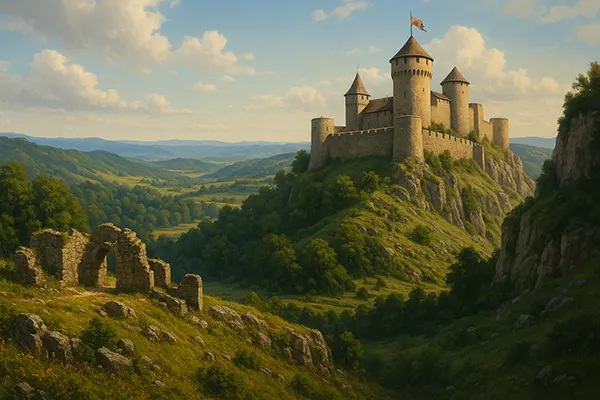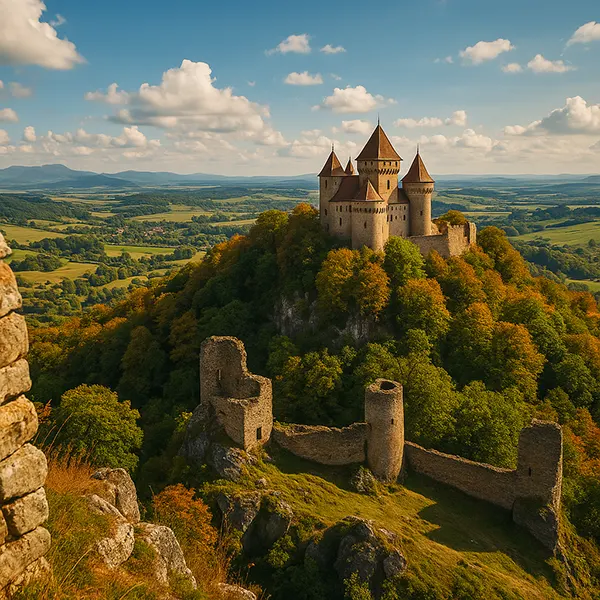
Forgotten Kingdoms: Tracing Lesser-Known Medieval States of Europe
Europe’s mediaeval tapestry is rich not only with mighty empires but also with obscure kingdoms that shaped regional identities and histories. Many of these forgotten states played a key role in political alliances, religious transformations, and cultural development. Today, we rediscover the trails of four such realms — the Kingdom of Navarre, Great Moravia, the Kingdom of Ruthenia, and Transylvania — and explore how their legacies survive through fortresses, museums, and regional lore.
Kingdom of Navarre: A Realm Between Mountains and Crowns
Once spread across parts of modern-day Spain and France, the Kingdom of Navarre thrived between the 9th and 16th centuries. It was a bridge between Christian and Muslim worlds during the Reconquista and often changed hands between dynasties from Castile, Aragon, and France. The kingdom’s strategic Pyrenean location made it a melting pot of languages and cultures, from Basque and Occitan to Latin and Spanish.
Despite its eventual absorption into Spain in the 16th century, Navarre maintained strong regional traditions and autonomy for centuries. Pamplona, its capital, is more than just the site of the Running of the Bulls — its historic old town and royal citadel echo Navarrese grandeur. The Monastery of Leyre and the Castle of Olite are enduring reminders of the region’s spiritual and military heritage.
Travellers interested in medieval heritage can follow the Camino de Santiago’s northern routes through Navarre, visiting ancient monasteries and fortresses nestled in the Pyrenean foothills. These routes offer not only scenic beauty but also a vivid sense of Navarre’s layered identity and medieval resilience.
Modern Routes and Cultural Heritage
Today, the best way to explore Navarre’s medieval sites is by following thematic routes such as the “Ruta de los Castillos.” Key destinations include the fortified village of Ujué and the Palace of the Kings of Navarre in Estella-Lizarra. Each site is well-marked and accessible by car or regional transport.
Pamplona’s Museo de Navarra offers a detailed historical account of the kingdom, with artefacts from Roman, Visigothic, and medieval periods. Digital displays and reconstructions provide context for how the kingdom evolved under political and religious pressures.
For blog and content creators, Navarre’s landscape offers cinematic valleys, Romanesque churches, and fortified ruins perfect for immersive storytelling. GPS-enabled interactive maps provided by the Navarre Tourism Board make site navigation intuitive and engaging.
Great Moravia: The Cradle of Slavic Christianity
Established in the 9th century, Great Moravia was a powerful Slavic state stretching over modern-day Czechia, Slovakia, and parts of Hungary and Austria. It played a pivotal role in the Christianisation of Central Europe, hosting Saints Cyril and Methodius, who introduced the Glagolitic script and laid the foundation for Slavic liturgy.
The political centre of Great Moravia is believed to have been in the region around Mikulčice and Velehrad in the Czech Republic. Archaeological findings, including basilicas, palatial foundations, and early Christian tombs, reveal the sophistication of this early Slavic state. Despite its fall in the early 10th century, it heavily influenced future Czech and Slovak identity.
While no intact fortresses remain, the region’s archaeological parks and open-air museums offer an immersive look into Moravian society. Visitors can walk through reconstructed early medieval settlements, complete with wooden palisades and early Christian chapels.
What to Visit in Moravia Today
The Great Moravia Monument in Staré Město near Uherské Hradiště includes a museum with artefacts from the empire’s height. Nearby, the Velehrad Basilica — a pilgrimage site — commemorates the mission of Cyril and Methodius, with annual cultural and religious festivals.
Mikulčice-Valy is the most extensive archaeological site from the Moravian period, featuring interactive installations, a reconstructed Slavic settlement, and walking trails through the excavation area. Guided tours are available in English and German.
Modern travel blogs increasingly highlight this region for cultural tourism, with suggested routes including castles from later Czech history to create a fuller picture of Bohemian-Moravian continuity. Local guides often link medieval heritage to modern folklore traditions and regional wine culture.

Kingdom of Ruthenia: The Western Edge of the Kievan Legacy
Located in present-day Zakarpattia (Ukraine), the Kingdom of Ruthenia flourished from the 13th to the 15th century. It emerged from the fragmentation of Kievan Rus’ and was influenced by both Orthodox and Catholic traditions due to its proximity to Hungary and Poland. Uzhhorod and Mukachevo served as key urban centres in the kingdom’s development.
Ruthenia’s historical significance lies in its role as a crossroads of East and West, hosting nobles, traders, and clerics from across the Carpathians. The region’s castles, such as Palanok Castle in Mukachevo, still tower above the landscape, offering glimpses into its feudal complexity and military significance.
The kingdom’s decline came with its gradual incorporation into the Kingdom of Hungary and later the Austro-Hungarian Empire. However, local traditions, ecclesiastical architecture, and multilingual culture preserve Ruthenia’s distinct medieval identity even today.
Key Sites in Zakarpattia
Palanok Castle is the region’s most iconic fortress, with exhibitions dedicated to medieval weaponry, noble dynasties, and regional history. Its well-preserved bastions and panoramic views attract both history enthusiasts and photographers.
Uzhhorod Castle, dating back to the 9th century, blends Ruthenian, Hungarian, and Slavic influences. The adjacent museum showcases folk crafts, religious art, and documents from the region’s complex administrative past.
Travel creators often focus on the cultural mix and the region’s unique dialects. Zakarpattia’s medieval story can be traced via digital itineraries from Visit Ukraine, combining architecture, cuisine, and highland routes through the Carpathians.
